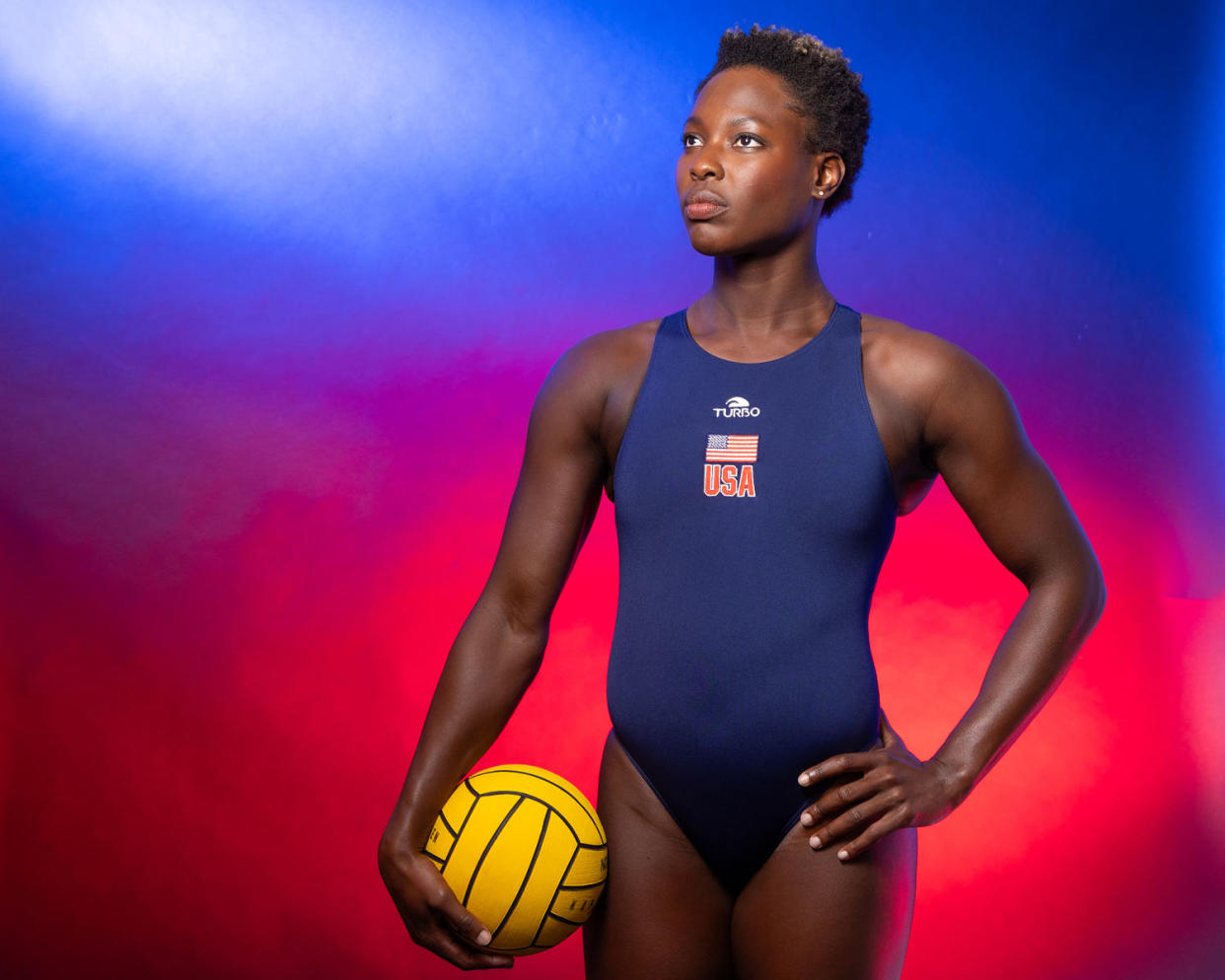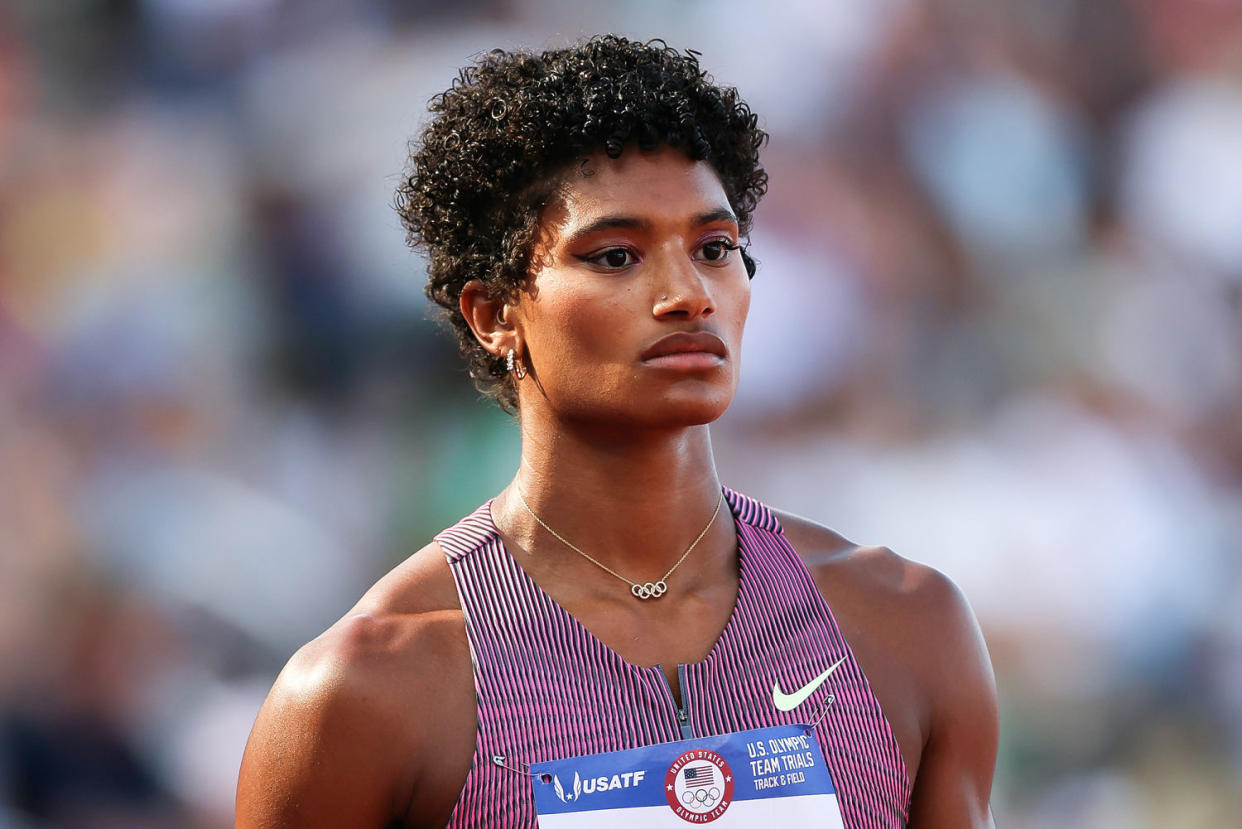'Look good, run fast': Black Olympians discuss the importance of their hair
Black American women competing in the 2024 Olympics are in a massive spotlight — and so is their hair.
Kendall Ellis, a 28-year-old sprinter, said she’s planning to highlight her kinky hair texture when she competes in Paris. After she qualified for the Olympics, she said, “it was one of the first things I thought about!” Ellis said she plans to wear a sew-in — hair extensions sewn over her braided hair — that is similar to her natural hair texture.
“I want to do a more natural-looking style, because I think it’s important to have that representation on such a large stage,” Ellis said.
As Ellis, a 400-meter runner, returns to the Games, she won’t be the only Black female athlete thinking about how she’ll wear and manage her hair. Competitors like water polo goalkeeper Ashleigh Johnson and track athletes Brittany Brown and Anna Cockrell represent a swath of Olympians approaching hair care in Paris not with dread and uncertainty, but as an opportunity to showcase their personal styles.
“If you look good, you run fast!” said Brown, who will race the 200-meter sprint.
Black women in athletics have always faced scrutiny over their hair, from Venus Williams’ being penalized over her famous beaded hairstyle and controversy over swim caps for natural hair to the ridicule gymnasts like Gabby Douglas and Simone Biles faced for not having their hair “done.”
Ketra Armstrong, the director of the Center for Race and Ethnicity in Sport at the University of Michigan, said this new generation of athletes is pushing back against hair discrimination.
“For a while, Black women have had to make themselves presentable in a way that wasn’t perceived to be unkept or unprofessional,” Armstrong said. “Black women were judged by their hair, called not professional or not qualified. We’re at a point now where Black women are reclaiming their crown.”
For example, swimmer Simone Manuel publicly shared her hair care routine, while others, like 100-meter sprinter Sha’Carri Richardson, have modeled bright-colored wigs and elaborate braids at the starting line.
The Paris Olympics will feature a similarly defiant posture from Black women who are prioritizing looks that make them feel stylish and beautiful while protecting their kinky, curly tresses.
Paris will mark Johnson’s third time at the Olympics. She said her relationship with her hair has come a long way since her first Games in 2016. She intentionally keeps her hair short and natural. She’s usually seen in professional photos with her short, natural hair — now dyed blond at the top.
She said that for Paris, though, she plans to wear cornrows with a touch of color, a style that will be close to her head under her swim cap and allow her to glide through the water.
“Having a protective style is a big part of maintaining my hair’s health right now,” Johnson said. “I feel like I’m helping my hair. I can reach my hair goals while also competing at this level.”

Johnson said spending so much time in the water often leaves her hair dry, so she relies on brands like Camille Rose, Rizos Curls and Biolage to keep her hair hydrated. She adds a little water and Rizos Curls’ leave-in conditioner to a spray bottle and “and I spray my hair with that after every practice.”
Johnson said she has noticed a lot of hair-centered camaraderie among Black women across sports. They connect one another with hair braiders and stylists and share where to get styles like silk presses. Johnson added that she loves being able to experiment with her hair and loves seeing other Black women do the same in sports.
Richardson, known for her colorful hairstyles just as much as her speed, has drawn from the examples of stylish Olympic sprinters Florence Griffith Joyner (or “Flo-Jo”) and Gail Devers. Her colorful wigs and intricate braids and even her natural hair helped launch Richardson into stardom in 2019.
“My lane is my catwalk,” she recently told Vogue. “We glam up! We put it on! When we step forward we’re ready no matter what. Look good, feel good, do good. That all relates to the mental aspect, the emotional aspect and ultimately the physical.”
Though Brown, Johnson, Ellis and Cockrell are well able to care for their hair, they said they’d love to eventually have stylists who can travel with them — like Simone Biles’ stylist, Jazmine Johnson.
Johnson styles Biles’ hair for her competitions and personal occasions, like her wedding last year. She said Biles enjoys hair extensions, sew-ins and, when she’s competing, updos. But Johnson prioritizes the health of Biles’ hair over the style the champion gymnast may want at the moment.
“There is no one product for a Black athlete, but each athlete should have a routine,” she said. “If they have a hair care routine and a brand they stick by, they will get better results. You need to find what works for you.”

The natural hair movement of the last 15 years has brought with it the proliferation of Black-centered hair care products from major brands and new, Black-owned hair care brands. Such products prioritize everything from hydration to strengthening hair after having worn box braids. They have been game changers for athletes who contend with sweat and too-tight ponytails.
Cockrell, a 26-year-old track and field star, said she swears by Innersense to care for her curly, natural hair. Before she cut her loose curls into a short style with tapered sides last year, Cockrell was known for wearing her big bouncy curls, with a few braids and accessories in front to keep her hair out of her face.
“I feel a lot freer with my short hair,” said Cockrell, a 400-meter hurdler. She added that she has a sort of ritual to prepare for every meet. “I shampoo twice then condition. I use a hydrating shampoo. I like to go into a race feeling fresh.”
She said her alone time doing her hair is “almost meditative.”
“It’s a time for me to be very intentional and be alone and listen to a podcast or listen to music and just be with myself and have a task versus laying in bed and being nervous,” she said.
There are, of course, challenges to having natural hair while competing in white-dominated sports. At the international level, swimming’s governing body, FINA (now known as World Aquatics), initially banned the Soul Cap — created to accommodate natural hair, braids, dreadlocks and weaves — from the Tokyo Olympics. It reversed the ban in 2022 after public outrage.
When they aren’t battling public ridicule and discriminatory rules, athletes face frustrating roadblocks like struggling to find stylists to do their hair — whether it be braids, wigs or hair extensions — when they travel for competitions. That has led athletes to switch to low-maintenance styles or learn to do their hair themselves.
Brown said she learned to cornrow by watching tutorials on YouTube so she could do her hair while on the go.
“It’s a unique Black girl challenge,” she said, laughing.
For more from NBC BLK, sign up for our weekly newsletter.





